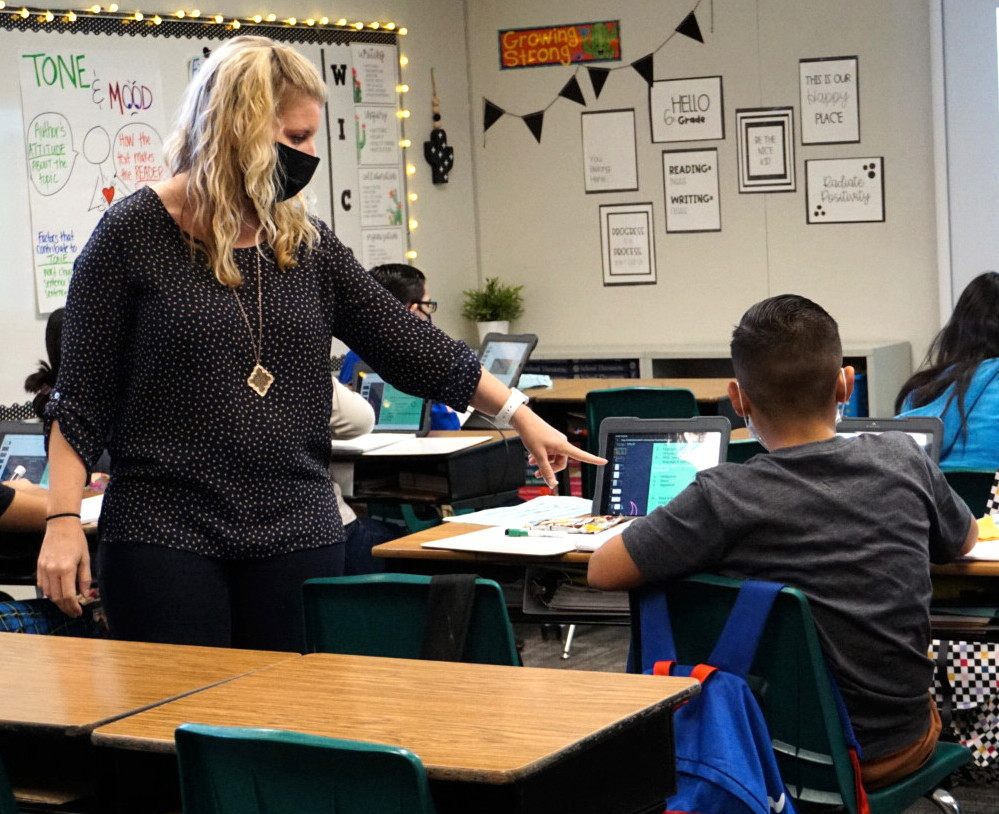“Unexpected learning” is the phrase educators at Sevilla Elementry School West Campus in Phoenix prefer to learning loss as they help students recover from COVID’s disruptions.
The shift to remote and online required students to learn some important soft skills that aren’t necessarily taught in classrooms, Principal Jennifer Bunch says.
“Students had to troubleshoot their own technology program, they had to learn to advocate for themselves—you don’t write lessons on that,” says Burch, whose school is part of Alhambra Elementary School District #68. “We decided to have a positive outlook and use positive language.”
Students advocated for themselves on district surveys this year by asking for more time for wellness. So, Burch and her team say this is an opportunity to provide wellness time for teachers, as well.
The school asked its teachers about their own wellness activities, and they are now teaching daily classes such as yoga, badminton, running, golf, coding, animation and video production, among other subjects. Students will rotate through four of the courses this school year.
One thing the school’s administrators realized at the start of this year is that educators had to “rebuild their stamina” for the normal school routine after 19 months of disruptions. “Wellness balances out the day,” Burch says. “We’re capitalizing on teachers’ hobbies and they’re teaching something they’re passionate about and students are benefiting.”
Pleasantly surprised
When it comes to academic progress, Burch says she and her team as “pleasantly surprised” about students’ progress this fall even as screeners have revealed foundational gaps in core math and English concepts such as phonics and fluency.

Sevilla West’s administrations and teachers have been building their data literacy skills to keep a laser focus on student achievement and “be intentional about every minute in the class,” Burch says.
Burch and her team created a master schedule for this school year that provides ample time for core instruction, intervention and advisory periods where students can get 1-on-1 help, and social-emotional learning. The schedule also gives teachers lots of time for professional development in concepts such as phonemic awareness and data literacy, neither of which, Burch says, had been prioritized at the school until this year.
About 300 of the school’s 720 students are receiving intensive academic support this school year. The school, which is 1-to-1 with iPads, also uses a learning platform that allows students to keep constant track of their grades and become more responsible for their own learning, Burch says.
“We can walk up to students and ask them about their progress and they can show you on their iPads,” she says. “If students do not know what their deficiencies are and if they’re improving, we are missing a very important piece to increase achievement.”
‘The luxury of interventionists’
Even though most students in Texas’ Friendswood ISD attended school in-person last year, some have struggled to readjust this fall, says Stacy Guzzetta, the executive director of student operations. The Houston-area district has stationed social-emotional learning counselors at its junior high and high school to work with students grappling with anxiety.
“After last year, with masks and activities canceled and not being as close to kids as we normally would be because of social distancing, we’re seeing challenges interacting with students,” Guzzetta says.
On the academic side, educators are trying to catch up students who didn’t make the gains they would have been expected to make in a normal school year. For example, kids who were in kindergarten pre-COVID have now jumped to second grade after a disrupted first-grade year. “It was really hard to learn to read on-screen and hard to learn to write and hold a pencil correctly on a screen,” she says.
So, the district used ESSER funds to hire interventionists and coaches to work with students at its four K-5 and K-3 campuses. The district has also added a college-and-career specialist to its high school faculty to refocus students on post-graduation pathways.
Overall, Friendswood ISD has spent about 85% of the latest round of ESSER money on personnel, hiring interventionists for two years and coaches for three with hopes of absorbing those positions into the budget when relief funds expire. “We never had the luxury of being able to afford interventionists before,” Guzzetta says.









